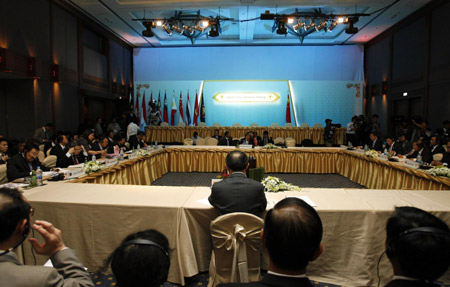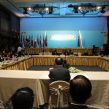
China-ASEAN Free Trade Area: A Chinese “Monroe Doctrine” or “Peaceful Rise”?
Publication: China Brief Volume: 9 Issue: 17
By:

China’s economic ascent since the early 2000s has generated more equanimity than the fear its military rise caused in the mid-1990s, which led to accelerated concerns in the international community about a “China threat.” While the Chinese military continues to modernize and its defense budget grows by double digits, China’s expanding economy is now regarded more as an opportunity than a threat, and helps the country conduct a savvy “new” diplomacy with confidence.
Nowhere is this shift in perceptions toward China’s rise more evident than in Southeast Asia, especially in terms of the changing attitudes of ASEAN (Association of Southeast Asian Nations), which was formed in 1967 partly as a collective response to China—which supported communist insurgents in the region—and did not normalize relations with China until the 1990s. Thus, the plan to create an ASEAN-China Free Trade Agreement (ACFTA) by 2010 for the ASEAN 6 (Brunei, Indonesia, Malaysia, the Philippines, Singapore, and Thailand) and 2015 for the newer members (Cambodia, Laos, Myanmar [Burma], and Vietnam) signaled a profound change in the relationship between China and Southeast Asia. Covering a total population of 1.7 billion people and a combined GDP of about $2 trillion, ACFTA is billed as the largest free-trade zone in the world. ACFTA is estimated to boost ASEAN’s GDP by 0.9 percent and China’s by 0.3 percent [1].
China’s emergence as an avid pursuer of FTAs happened in spite of its latecomer status. China did not begin its pro-market economic reform until 1978-9 and did not join the World Trade Organization (WTO) until the end of 2001. Beginning in 2002, China has signed FTAs with Chile (2005), Pakistan (2006), New Zealand (2008, its first with a developed country), and Peru (2009) and is currently studying, negotiating, or implementing FTAs with over 20 countries or regions (China Daily, April 29; People’s Daily, February 9, 2006) [2].
China’s impressive trade offensive typifies its “new” foreign policy thinking. Yet, it is not clear whether this “trade diplomacy” represents a long-term and fundamental shift in Chinese statecraft or only a short-term tactical expedient aimed at buying the crucial time that Beijing needs in order to become the preeminent actor in the region capable of securing its military interests and projecting its power. It also raises the question of whether China’s active economic diplomacy in East Asia will spur commercial competition in this region where great-power conflict is still possible.
Despite the standard economic rationales offered by Chinese officials (such as helping increase Chinese exports, ensuring access to markets and raw materials, and attracting foreign investment), the main motivation for China’s trade activism appears strategic. In the case of Southeast Asia, China’s FTA with the ASEAN is driven by a political logic that responds to challenges posed by competitive regionalisms in the world economy, to cement growing economic ties with Southeast Asian nations and to alleviate their fear of a rising China, to secure raw materials crucial to China’s economic development, and to ensure a peaceful and stable environment close to home so as to buttress China’s growing influence and counterbalance American and Japanese power. It has thus been interpreted as a concrete example of economic statecraft employed to bolster the image of China’s “peaceful rise.”
ASEAN nations are attracted by the opportunities brought about by China’s economic expansion and trade liberalization; they also seek to leverage their FTA with China to additional FTAs with important trading partners within (e.g. Japan) or outside (e.g. the United States) the region.
Although there are economic benefits for pursuing FTAs, nations often pursue them for non-economic reasons (e.g. strengthening alliance, increasing peace and security, enhancing collective bargaining power, locking in institutional reform, and sharing resources). Regionalism (and FTAs in particular) plays a critical role in China’s current grand strategy—“peaceful rise.”
The policy of “peaceful rise” is based on an embrace of globalization as part of the solution to China’s growth imperatives. It relies both on China’s domestic economy and the international marketplace to sustain and fuel economic growth. To achieve the goal of rising to great power status, Chinese leaders believe that it must secure a peaceful international environment that is crucial to sustaining China’s economic development and augmenting China’s power. Ensuring stability in China’s periphery and avoiding a premature showdown with the United States are thus essential [3].
To achieve the goal of “peaceful rise,” China has refashioned its diplomacy. Rather than continuing to act like an aggrieved victim, China now aspires to be a responsible great power and is acting increasingly like one. Whereas China used to distrust “multilateralism” for fear that multilateral institutions could be used to constrain or punish it, now Chinese leaders recognize that deeply engaging these organizations help promote the country’s trade and security interests and limit American power. On many contentious and intractable issues, China has adopted more pragmatic stances. China is more aware that its rise has consequences for the Asia-Pacific region and beyond. So it is keen on easing the concerns of various countries. Moreover, China has become much more actively engaged in, and seeks to shape, regional affairs. Its hosting of the Six-Party Talk over North Korea’s nuclear issue is a good example. The major instrument used in advancing China’s objectives is its economic power, which is buoyed by its phenomenal economic growth, rapidly expanding domestic markets, and driven by its voracious appetite for raw materials needed for its economic development.
To sum up, China’s “peaceful rise” is a comprehensive long-term strategy leveraging globalization as a catalyst to accelerate China’s economic development and elevate China’s power and stature.
In this context, Southeast Asia is an important arena for China’s new economic diplomacy and a test case of Beijing’s credibility as a “responsible stakeholder.” Some noted regional analysts are concerned that ACFTA may turn the region into a “backyard for Chinese raw material imports and manufactured exports, and hence a natural candidate for a Chinese sphere of influence” [4]. For example, Rodolfo Severino, former ASEAN secretary-general, warned that such industries as textiles, toy, and motorcycle manufactures would be negatively affected in the short term, although he believed long-term benefits would follow (Australian Business Intelligence (October 8, 2002). Furthermore, because of its almost inexhaustible unskilled labor and huge amounts of FDI, China may pose a special challenge to the ASEAN-4 in their home or third-country markets.
There are also broader strategic implications of China’s success in Southeast Asia that is worth noting. In light of China’s activism in the ASEAN Plus Three (APT) and East Asian Summit (EAS) initiatives—both explicitly exclude the United States—will a Chinese version of the “Monroe Doctrine” loom over East Asia?
The first reason for this fear is a historical legacy of hierarchy that characterized China-Southeast Asian relations. Most nations in the region fell under China’s tributary system—“a reciprocal foreign relationship between superior and inferior” in which tribute offerings were normally reciprocated by lavish gifts from the Chinese emperor. Some scholars argue that “accepting China’s supremacy was materially worthwhile,” since the tribute system became the institutional setting and indeed “cover for foreign trade” early on [5].
In a modern twist, Chinese leader Hu Jintao, in his report to the 17th Congress of the CCP, singled out trade as an important instrument for China to achieve its goal of “peaceful development.” The same report reiterated that China would accommodate the “legitimate concerns” of developing countries (hinting early harvest) and support efforts to close the North-South gap [6].
The other important reason is the size asymmetry between China and Southeast Asia. China towers over each individual ASEAN member and all of them combined. AFTA (ASEAN Free Trade Area) intends to create a regional market of over 500 million people. Yet even this combined ASEAN magnitude would only constitute 29 percent of the population, 32 percent of the GDP, and 46 percent of the trade volume, of the combined ASEAN-China FTA. This is why there is a widely accepted view, expressed by Singaporean Trade and Industry Minister George Yeo, that an integrated ASEAN is the only viable response to an economically-rising China (The Straits Times, November 12, 2002).
Thirdly, in contrast to China’s coherent strategic goal, ASEAN does not have a clear picture about its place in the new strategic environment of an emergent China. Lured by the China market (especially the so-called “early harvest” provisions for the ASEAN-4), some analysts worry that ASEAN risks becoming a fringe player on the spokes of China’s regional trade architecture, while further enhancing the attractiveness of China as the hub for regional investment and production (Australian Financial Review, November 12, 2002). In this view, ASEAN will be reduced to a role of auxiliary actor in the main show—China’s rise. China can also turn out to be a fierce competitor—having already attracted the lion’s share of FDI into developing countries and having posed special challenges to manufactured goods from ASEAN. Furthermore, there are real concerns that ACFTA may undermine ASEAN’s own FTA thanks to China’s “divide and conquer” negotiation tactic, because individual ASEAN members may now pay more attention to ACFTA than AFTA.
Admittedly, under the sovereign state system, a return to a modern version of the tributary system is not very plausible. China’s economic diplomacy has presented opportunities and challenges for East Asia. On the one hand, ASEAN nations have tried to “bind” China through regional institutions, such as ACFTA, APT, EAS, and ARF (Asian Regional Forum), raising the cost of Chinese belligerence. Indeed, China’s FTA activism has spurred measures by Japan and India to strengthen their own economic diplomacy in Southeast Asia. For instance, since the ACFTA was enacted, Japan has signed FTAs with Singapore, Malaysia, Indonesia, Thailand, and the Philippines.
In contrast, the interest of the United States in the region, as shown through the lens of economic diplomacy, pales in comparison [7]. Since 2004, China has replaced the United States as the largest trading partner of Japan, South Korea, Taiwan, India, Australia, Brazil, and Chile. Admittedly this is mainly due to the rise of China as a world trader, but it is also an indicator of America’s relative declining influence. The United States has only signed FTAs with Singapore and South Korea (the latter still not ratified by Congress). The United States’ hope of engaging in a FTA with the entire membership of APEC (Asia-Pacific Economic Cooperation) also looks less appealing or feasible than China’s bilateral FTAs, especially against the backdrop of the failed Doha Round of WTO multilateral talks.
China’s economic statecraft toward Southeast Asia will provide the material support for its stated goal of “peaceful rise,” augment its stature and influence in regional and world affairs, and present a challenge to the United States that calls for the need for Washington to shore up its economic competitiveness and attention toward this key region.
Notes
1. Amitav Acharya, “China and Southeast Asia: Some Lessons for Africa?” in Kweku Ampiah and Sanushu Naidu, eds., Crouching Tiger, Hidden Dragon? Africa and China (University of KawZulu-Natal Press, 2008), p. 322.
2. For a list of bilateral FTAs submitted to WTO, see www.wto.org/english/tratop_e/region_e/eif_e.xls.
3. See Vincent Wei-cheng Wang, “The Logic of China-ASEAN FTA: Economic Statecraft of ‘Peaceful Ascendancy,’” in China and Southeast Asia: Global Changes and regional Challenges, eds., Ho Khai Leong and Samuel C. Y. Ku (Singapore: Institute of Southeast Asian Studies, 2005), pp. 17-41.
3. Ibid., 32-34.
4. Acharya, “China and Southeast Asia,” p. 316.
5. John King Fairbank and Merle Goldman, China: A New History, enlarged ed. (Cambridge, MA: Harvard University Press, 1998), pp. 112-3; David Kang, “Hierarchy and Stability in Asian International Relations,” in G. John Ikenberry and Michael Mastanduno, eds., International Relations Theory and the Asia-Pacific (New York: Columbia University Press, 2003), pp. 172-3.
6. Full text of Hu’s report can be found at https://www.newsgd.com/specials/17thPartyCongress/News/content/2007-10/25/content_4264493.htm.
7. During the author’s field research in Singapore in 2007, several informants compared America’s lack of engagement with Southeast Asia against China’s charm offensive.





